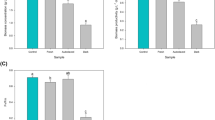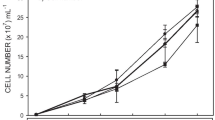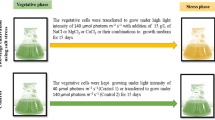Abstract
Co-cultivation of plants and microalgae represents an optimized production method which is less resource intense and it is ecologically correct and clean. Hydroponically grown plants may have higher yields and better quality. The possibility of Swiss chard and Chlorella vulgaris co-cultivation and their joint impact on microalgae growth parameters such as optical and cell culture density, dry weight, biomass productivity, and pigment content were investigated. Swiss chard growth parameters (plant length, fresh and dry weight, root volume, and leaves number) were monitored and measured. Hydroponic medium used in the experiment was analyzed to estimate C. vulgaris effect on its quality parameters (chemical oxygen demand, pH, electrical conductivity, and total nutrients consumption). Nutrient removal efficiency was calculated, as well. This study proved simultaneously nutrient removal efficiency, extracellular production, and positive effect on plant growth. In Hoagland’s solution, co-culture, and monoculture, total nitrogen and phosphorus removal efficiency ranged from 92.41 to 97.48% and 96.41 to 99.96%, respectively. Monoculture C. vulgaris showed better growth and higher pigment (chlorophyll a, b and carotenoids) content. Furthermore, microalgae C. vulgaris did not interfere with Swiss chard development. Higher leaves number (18.56%), total fresh weight (17.13%), and root volume (36.98%) have proven the advantage of coupled cultivation rather than usage of Hoagland’s growth medium alone. Results demonstrated practicability of C. vulgaris–Swiss chard co-cultivation and its potential applicability, all in order to provide more sustainable and economically viable large-scale plant production in future.






Similar content being viewed by others
Data availability
The datasets generated during and/or analyzed during the current study are available from the corresponding author on reasonable request.
References
Abiusi F, Wijffels RH, Janssen M (2020) Doubling of microalgae productivity by oxygen balanced mixotrophy. ACS Sustain Chem Eng 15:6065–6074
Ajala SO, Alexander ML (2020) Assessment of Chlorella vulgaris, Scenedesmus obliquus, and Oocystis minuta for removal of sulfate, nitrate, and phosphate in wastewater. Int J Energy Environ Eng 11:311–326
Anpo M, Fukuda H, Wada T (2019) Introduction: artificial light-type plant factories—outline and a vision for the future. In: Anpo M, Fukuda H, Wada T (eds) Plant factory using artificial light. Elsevier, Amsterdam pp xxiii-xxviii
Arora N, Philippidis GP (2021) Insights into the physiology of Chlorella vulgaris cultivated in sweet sorghum bagasse hydrolysate for sustainable algal biomass and lipid production. Sci Rep 11:6779
Barone V, Puglisi I, Fragala F, Piero ARL, Giuffrida F, Baglieri A (2019) Novel bioprocess for the cultivation of microalgae in hydroponic growing system of tomato plants. J Appl Phycol 31:465–470
Bharti A, Prasanna R, Kumar G, Kumar A, Nain L (2019) Co-cultivation of cyanobacteria for raising nursery of chrysanthemum using a hydroponic system. J Appl Phycol 31:3625–3635
Bulgari R, Baldi A, Ferrante A, Lenzi A (2016) Yield and quality of basil Swiss Chard, and rocket microgreens grown in a hydroponic system. N Z J Crop Hort 45:119–129
El-Kassas HY, Laila Abdelfattah M (2014) Bioremediation of the textile waste effluent by Chlorella vulgaris. Egypt J Aquat Res 40:301–308
Fisher RA (1990) Statistical methods, experimental design and scientific inference. In: Bennett JH, Yates F (eds) A re-issue of Statistical Methods for Research Workers, “The Design of Experiments”, and “Statistical Methods and Scientific Inference.” Oxford University Press, Oxford
Guillard RRL, Sieracki MS (2005) Counting cells in cultures with the light microscope. In: Anderson RA (ed) Algal culturing techniques. Elsevier Academic Press, London, pp 239–252
Guzzon A, Bohn A, Diociaiuti M, Albertano P (2008) Cultured phototrophic biofilms for phosphorus removal in wastewater treatment. Water Res 42:4357–4367
Hajnal-Jafari T, Đurić S, Stamenov D (2016) Influence of green algae Chlorella vulgaris on initial growth of different agricultural crops. Matica Srpska J Nat Sci 130:29–33
Hajnal-Jafari T, Seman V, Stamenov D, Đurić S (2020) Effect of Chlorella vulgaris on growth and photosynthetic pigment content in Swiss chard (Beta vulgaris L. subsp. cicla). Pol J Microbiol 69:1–4
Huo S, Liu J, Addy M, Chen P, Necas D, Cheng P, Li K, Chai H, Liu Y, Ruan R (2020) The influence of microalgae on vegetable production and nutrient removal in greenhouse hydroponics. J Clean Prod 10:118563
Kameoka T, Hashimoto A (2019) Assessment from food science. In: Anpo M, Fukuda H, Wada T (eds) Plant factory using artificial light. Elsevier, Amsterdam, pp 131–141
Kholssi R, Marks EAN, Miñón J, Montero O, Debdoubi A, Rad C (2019) Biofertilizing effect of Chlorella sorokiniana suspensions on wheat growth. J Plant Growth Regul 38:644–649
Kim MJ, Shim CK, Kim YK, Ko BG, Park JH, Hwang SG, Kim BH (2018) Effect of biostimulator Chlorella fusca on improving growth and qualities of Chinese chives and spinach in organic farm. Plant Pathol J 34:567–574
Kim S, Park JE, Cho YB, Hwang SJ (2013) Growth rate, organic carbon and nutrient removal rates of Chlorella sorokiniana in autotrophic, heterotrophic and mixotrophic conditions. Bioresour Technol 144:8–13
Kumar A, Ergas S, Yuan X, Sahu A, Zhang Q, Dewulf J, Malcata FX, Van Langenhove H (2010) Enhanced CO2 fixation and biofuel production via microalgae: recent developments and future directions. Trends Biotechnol 28:371–380
Kumar A, Surojit B (2020) Revisiting nitrogen utilization in algae: a review on the process of regulation and assimilation. Bioresour Technol Rep 12:100584
Lee SA, Lee N, Oh HM, Ahn CY (2019) Enhanced and balanced microalgal wastewater treatment (COD, N, and P) by interval inoculation of activated sludge. J Microbiol Biotechnol 29:1434–1443
Lichtenthaler HK (1987) Chlorophylls and carotenoids: pigments of photosynthetic biomembranes. Meth Enzymol 148:350–382
Mazepa E, Malburg B, Mógor G, Oliveira A, Amatussi J, Corrêa D, Lemos J, Ducatti D, Duarte ME, Mógor A, Noseda M (2021) Plant growth biostimulant activity of the green microalga Desmodesmus subspicatus. Algal Res 59:102434
Mazur H, Konop A, Synak R (2001) Indole-3-acetic acid in the culture medium of two axenic green microalgae. J Appl Phycol 13:35–42
Powell N, Shilton A, Chisti Y, Pratt S (2009) Towards a luxury uptake process via microalgae – defining the polyphosphate dynamics. Water Res 43:4207–4213
Ranglová K, Lakatos GE, CâmaraManoel JA, Grivalský T, Suárez Estrella F, Fernández FGA, Molnár Z, Ördög V, Masojídek J (2021) Growth, biostimulant and biopesticide activity of the MACC-1 Chlorella strain cultivated outdoors in inorganic medium and wastewater. Algal Res 53:102136
Ray K, Mukherjee C, Ghosh AN (2013) A way to curb phosphorus toxicity in the environment: use of polyphosphate reservoir of cyanobacteria and microalga as a safe alternative phosphorus biofertilizer for Indian agriculture. Environ Sci Technol 47:11378–11379
Sahni P, Aggarwal P, Sharma S, Singh B (2019) Nuances of microalgal technology in food and nutraceuticals: a review. Nutr Food Sci 49:866–885
Schreiber C, Henning S, Harrison L, Briese C, Ackermann B, Kant J, Schrey SD, Hofmann D, Singh D, Ebenhoh O, Amelung W, Schurr U, Mettler-Altmann T, Huber G, Jablonowski ND, Nedbal L (2018) Evaluating potential of green alga Chlorella vulgaris to accumulate phosphorus and to fertilize nutrient-poor soil substrates for crop plants. J Appl Phycol 30:2827–2836
Schüler L, Greque de Morais E, Trovão M, Machado A, Carvalho B, Carneiro M, Maia I, Soares M, Duarte P, Barros A, Pereira H, Silva J, Varela J (2020) Isolation and characterization of novel Chlorella vulgaris mutants with low chlorophyll and improved protein contents for food applications. Front Bioeng Biotechnol 8:489
Schwarz D, Gross W (2004) Algae affecting lettuce growth in hydroponic systems. J Hortic Sci Biotech 79:554–559
Shin WS, Lee B, Jeong BR, Chang YK, Kwon JH (2016) Truncated light-harvesting chlorophyll antenna size in Chlorella vulgaris improves biomass productivity. J Appl Phycol 28:3193–3202
Shukla PS, Mantin EN, Adil M, Bajpai S, Critchley AT, Prithiviraj B (2019) Ascophyllum nodosum-based biostimulants: sustainable applications in agriculture for the stimulation of plant growth, stress tolerance, and disease management. Front Plant Sci 10:655
Solovchenko A, Verschoor AM, Jablonowski ND, Nedbal L (2016) Phosphorus from wastewater to crops: an alternative path involving microalgae. Biotechnol Adv 34:550–564
Song X, Wang J, Wang Y, Feng Y, Cui Q, Lu Y (2018) Artificial creation of Chlorella pyrenoidosa mutants for economic sustainable food production. Bioresour Technol 268:340–345
Stirk WA, Ördög V, Novák O, Rolčík J, Strnad M, Bálint P, Van Staden J (2013) Auxin and cytokinin relationships in 24 microalgal strains. J Phycol 49:459–467
Sukačová K, Červený J (2017) Can algal biotechnology bring effective solution for closing the phosphorus cycle? Use of algae for nutrient removal. Eur J Environ Sci 7:63–72
Supraja KV, Bunushree B, Balasubramanian P (2020) Performance evaluation of hydroponic system for co-cultivation of microalgae and tomato plant. J Clean Prod 272:122823
Uysal O, Uysal FO, Ekinci K (2015) Evaluation of microalgae as microbial fertilizer. Eur J Sustain Dev 4:77–82
Van Do TC, Tran DT, Le TG, Nguyen QT (2020) Characterization of endogenous auxins and gibberellins produced by Chlorella sorokiniana TH01 under phototrophic and mixtrophic cultivation modes toward applications in microalgal biorefinery and crop research. J Chem 2020:4910621
Waterbury JB, Stanier RY (1981) Isolation and growth of cyanobacteria from marine and hypersaline environments. In: Starr MP, Stolp H, Trüper HG, Balows A, Schlegel HG (eds) The prokaryotes. Springer, Berlin, pp 221–223
Wellburn AR (1994) The spectral determination of chlorophyll a and b, as well as total carotenoids, using various solvents with spectrophotometers of different resolutions. J Plant Physiol 144:307–313
Yu H, Kim J, Lee C (2019) Nutrient removal and microalgal biomass production from different anaerobic digestion effluents with Chlorella species. Sci Rep 9:6123
Zhang J, Wang X, Zhou Q (2017) Co-cultivation of Chlorella spp. and tomato in a hydroponic system. Biomass Bioenergy 97:132–138
Acknowledgements
This study was funded by Ministry of Education, Science and Technological Development of the Republic of Serbia (contract number: 451-03-9/2021-14/200117).
Funding
This study was funded by Ministry of Education, Science and Technological Development of the Republic of Serbia (contract number: 451–03-9/2021–14/200117).
Author information
Authors and Affiliations
Contributions
Vladimira Žunić: conceptualization, methodology, investigation, formal analysis, writing — original draft. Timea Hajnal-Jafari: supervision, conceptualization, funding acquisition, writing — review and editing, validation. Jasna Grabić: methodology, formal analysis, writing — review and editing. Simonida Đurić: resources, validation. Dragana Stamenov: resources, project administration.
Corresponding author
Ethics declarations
Conflict of interest
The authors declare no competing interests.
Additional information
Publisher's note
Springer Nature remains neutral with regard to jurisdictional claims in published maps and institutional affiliations.
Rights and permissions
About this article
Cite this article
Žunić, V., Jafari, T.H., Grabić, J. et al. Hydroponic systems: exploring the balance between co-cultivation of Chlorella vulgaris and Swiss chard (Beta vulgaris L. subsp. cicla). J Appl Phycol 34, 903–913 (2022). https://doi.org/10.1007/s10811-021-02673-z
Received:
Revised:
Accepted:
Published:
Issue Date:
DOI: https://doi.org/10.1007/s10811-021-02673-z




